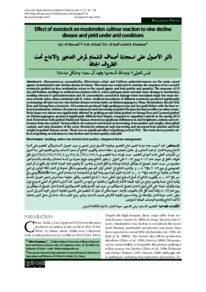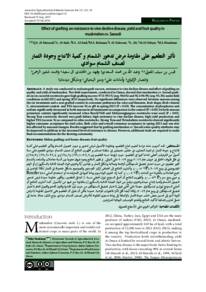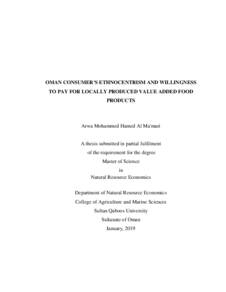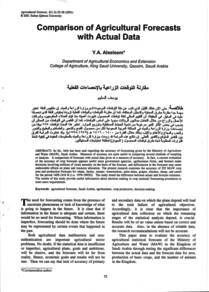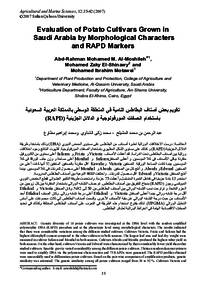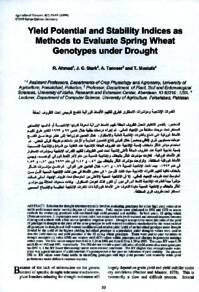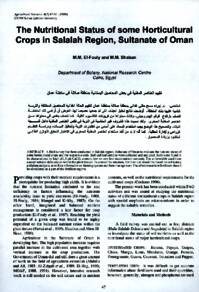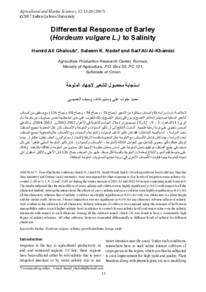Document
Effect of rootstock on muskmelon cultivar reaction to vine decline disease and yield under arid conditions.
Contributors
Publisher
جامعة السلطان قابوس. كلية العلوم الزراعية والبحرية
Gregorian
2016
Language
English
Subject
English abstract
Monosporascus cannonballus, Rhizoctonia solani and Pythium aphanidermatum are the main causal agents of muskmelon vine decline disease in Oman. This study was conducted to examine the response of six cucurbit rootstocks grafted on four muskmelon scions to the causal agents and fruit quality and quantity. The response of 10 day old Palmira seedlings to artificial inoculation with R. solani pathogen alone revealed more damage to muskmelon seedling whereas P. aphanidermatum and M. cannonballus caused less damage when inoculated singly but more disease severity index when combined with R. solani. Artificial inoculation of different rootstocks produced significantly no damping-off and very low vine decline disease severity index on Mubyeongjangsoo, Titan, Tetsukabuto, Rsscih7458, Ezra and Strong Tosa rootstocks. All rootstocks produced high grafting success and low graft failure with the four selected muskmelon cultivars. Rootstocks enhanced early harvesting of grafted Tamara but had no effect on other scions. Fruit shape was almost not significantly affected by grafting except Samit grafted on Strong Tosa and Caramel grafted on Mubyeongjangsoo produced significantly different fruit shapes compared to ungrafted controls in the spring 2013 trial. Fruits from both grafted Shahd and Tamara showed no significant differences in rind brightness, redness and yellowness from the control. Various effects of rootstock were found on harvesting, fruit number and weight, chlorophyll content, and stem diameter of the scion. Rootstocks enhanced early harvesting and increased fruit number and fruit weight in grafted Tamara scions. There was no significant effect of grafting on fruit TSS. The study shows positive effects of grafting on tolerance to vine decline and on fruit quality and yield.
Member of
ISSN
2410-1079
Resource URL
Citation
Al Mawaali, Q. S., Al-Sadi, A. M., Al-Said, F. A., & Deadman, M. L. (2016). Effect of rootstock on muskmelon cultivar reaction to vine decline disease and yield under arid conditions. Agricultural and Marian Sciences Journal, 21 (1), 47-56.
Arabic abstract
لقد أجريت هذه دراسة لتقييم نجاح التطعيم، ومقاومة الأصول لمرض تدهور و موت محصول الشمام وتأثر التطعيم على كمية الإنتاج وجودة الثمار. تم تنفيذ التجارب في حقلين منفصلين في سلطنة عمان، وأظهرت النتائج أن صنف الشمام سوادي المطعوم على ستة أصول من القرعيات أعطى نجاحا كبيرا في التطعيم: حيث تراوحت نسبة التطعيم بين 79.6-99.1% (98.6%) و92.4-96.9% (95.3%) في ظل ظروف الحقل في خريف عام 2012 وربيع 2013 على التوالي. لم تظهر النتائج وجود فروق معنوية بن الستة معاملات والشاهد (الشمام الغير مطعوم) من حيث اختبار تفضيل المستهلكين للرائحة وصلابة وشكل الثمار و فيتامين C ومحتوى المواد الصلبة الذائبة (السكروز%) أو الرقم الهيدروجيني في ربيع 2013 (p> 0.05). وأشارت النتائج إلى انخفاض تركيز الفوسفور والصوديوم بشكل ملحوظ في الثمار لكلا الموسمين في جميع المعاملات بالمقارنة مع الشاهد (p> 0.05). كما زاد محتوى البوتاسيوم زيادة كبيرة في الثمار عندما تم استخدام أصلي 7458Rsscih وموبي ينج سو (p< 0.05). وأظهرت النتائج أن أصل السترنج توزاء أعطى نسبة 0% لفشل التطعيم ، وأظهر مقاومة جيدة لمرض تدهور محصول الشمام وكمية إنتاج جيدة ومحتوى مرتفع من المواد الصلبة الذائبة (السكروز%) بالمقارنة مع غيره من الأصول. كما أشارت النتائج أن أصلي السترنج توزاء وتيتسوكابوتو حصلا على أعلى قبول لاختبار تفضيل المستهلكين من حيث لون القشرة واللون اللحم والقبول العام لاختبار تفضيل المستهلكين في ربيع عام 2013، وكانا أيضا أقل تأثرا بالتغيرات الموسمية. عموما يمكن أن نقول أن التطعيم على الأصول المقاومة لأمراض التربة أدى إلى تحسين بعض سمات جودة الثمار بالإضافة إلى زيادة مستوى المقاومة للأمراض لصنف الشمام سوادي. ومع ذلك، هناك حاجة إلى عمل تجارب إضافية لتأكيد النتائج ولتقديم التوصيات النهائية للمزارعين.
Category
Journal articles

